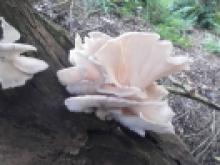Walking through woodland in late summer and autumn, one of the many interesting things we can find are the fungi that seem to appear without warning. Fungi can range from tiny near unnoticeable things to grand constructions that rival the trees surrounding them.
This week’s blog will explore these rather alien pieces of nature and how they impact our veteran trees.
SCEINCE ALERT! Fungi are not plants and they are not animals, they exist in their own group that evolved separately. They are not made up of cells like all other life they actually exist as hyphae – infinitely long and infinitely thin strands that grow through soils, wood and other materials and then, when the conditions are right they burst out in fruiting bodies and these are the weird and wonderful mushrooms, brackets, skins, balls and other myriad things we see above the surface. These release spores which go on to produce the next generation. Fungi can range from microscopic individuals impossible to see with the naked eye all the way up to the largest organism in the world – a single individual of honey fungus in the US has been recorded as covering 3.4 square miles and is estimated to be 2,400 years old.
So what have fungi got to do with trees?
Firstly, most trees couldn’t survive without fungi – 95% of plants require some form of fungi to survive, usually sharing nutrients with one another to allow them to grow. Secondly fungi are responsible for forming many of the valuable features we see on veteran trees. They hollow trees out and although they are sometimes helped by insects it’s almost always the fungi that start the job. And this is done by specialist “heart rot” species that digest only the non-living heart wood in the centre of the trunk and so leave the living wood to do its thing meaning the tree can survive healthily for centuries to come. Fungi also provide food and nest sites for hundreds, if not thousands of species of insects that go on to feed birds and mammals. When rot holes develop you will find a soupy mess of rain water and rotting detritus sitting in the bottom of the hole which provides habitat for rare hoverfly larvae. It’s the micro fungi that creates that soupy concoction.
We must not forget that fungi can be very interesting in their own right, and some species that live only on veteran trees can be quite rare – worth protecting!
In next week’s blog I’ll be exploring the creepy crawlies that live on veteran trees.
Tree Trivia: One traditional way of managing trees is to pollard them – this means cutting them off at about 4 to 5 feet high so that they’ll grow back, producing new useful timber where the new shoots are out of reach of grazing animals. This leaves a thick wooden stump sticking out of the ground and when the “p” in pollarding accidentally changed to a “b” we suddenly had our name for very similar objects on car parks and in our roads.




